|
|
Para ver este documento en español,
oprima aquí.
Puerto Rico: Divergence not Convergence
by Fernando Lefort*
June 1997
Executive Summary
This paper is based on a chapter of my doctoral dissertation
in economics, completed under the supervision of Professor Robert J. Barro
at Harvard University in 1996. It is an empirical application on the subject
of convergence theory, a tenet of neoclassical growth theory. The economic
performance of Puerto Rico can be clearly understood using this well known
economic theory.
*The author holds a Ph.D. at Harvard University.
He wishes to thank Robert J. Barro for illuminating conversations. Thanks
are also due to Francesco Caselli, J. Tomas Hexner, John V. Leahy, Michael
Levine, Gregory Mankiw and Glenn P. Jenkins for useful remarks. The author
is responsible for all errors. Comments are warmly welcome.
The principal conclusion of this research is that the economy of Puerto
Rico is not converging to the steady state level of per capita income of
the United States. Three other significant results were:
- The integrating effect of statehood is actually a vital economic,
and not just political, variable. It explains Puerto Rico's lack of economic
convergence toward the US.
- The cost of commonwealth is enormous. In 1994, the average Puerto
Rican would have been making $6000 more per year, if Puerto Rico had been
converging to the per capita income level of Mississippi (the poorest state
in the Union).
- Without statehood, Puerto Rico will never evolve sufficient economic
strength to converge with the mainland economy. Because of the lack of
economic convergence, statehood is, economically, a sink or swim matter.
At the end of the day, the question has always been: What would be the
cost of statehood? My analysis concludes that the opposite question should
have been asked: What has been the cost of commonwealth?
Convergence theory, upon which this challenge to conventional wisdom
is based, predicts that integrated entities (or economies with compatible
characteristics) tend to converge, more rapidly at the outset and at a slower
rate as they get closer to their target. This economic theory is somewhat
analogous to physiological growth. If an infant is destined to be 6 feet
tall, we could call "6 feet" her steady-state. While growing (in
transition) toward this steady-state, she will achieve the bulk of her height
rapidly and the remainder more slowly. Similarly, when one economy is converging
toward another, wealthier economy, it will experience high growth rates
as it "catches up" to its initial steady-state until the gap between
its steady-state and per capita income level lessens, and it finally converges
to a zero growth rate.
The territory to state convergence has a strong historical basis. Data
from 1880 to 1940 for the territories of Montana, Washington, Idaho, Wyoming,
Utah, Oklahoma, New Mexico, and Arizona shows that these economies experienced
a growth rate of 2% after making the transition from territory to state.
One can see a lucid example of how convergence theory works if one looks
at the economic performance of Mississippi. In fifty years Mississippi,
presently the poorest state, has been able to reduce by half the distance
that separates its per capita income level from that of Connecticut, the
wealthiest state.
In the meantime, since the 1970's Puerto Rico's per capita level is
lagging further and further behind the fifty states, with less than half
the per capita income of Mississippi. Historically, one would have expected
Puerto Rico to catch up to the US. It has not. Although Puerto Rico had
a good economic performance after World War II, it has experienced relative
stagnation and high unemployment since 1973. Why, then, has Puerto Rico's
economic performance been applauded? Very simply, Puerto Rico's economy
does relatively well in relation to Latin American and Caribbean countries.
These countries, however, have seen their income reduced in relation to
the more dynamic US economy. The point is that Puerto Rico should be compared
to and converging to the US, and not to countries south of the Rio Grande.
The conclusions of my thesis thus defy the conventional wisdom that
Puerto Rico needs to strengthen itself economically in order to be "ready"
for statehood. This expectation of a gradual economic strengthening will
never be fulfilled. From an economic perspective, Puerto Rico's situation
is a paradox. Puerto Rico will only qualify for statehood by being made
a state.
Table of Contents
1. Introduction
2. A Quick Look at the Convergence Hypothesis
3. Evaluating the Performance of Puerto Rico
3.1 Graphical Evidence
3.2 Panel Data Evidence Conclusions
- Explaining the Income Gap: Conditional Convergence
- Does Statehood Matter?
4. The Cost of Converging to a Lower Steady State
5. Summary and Conclusions
Appendix 1: The Puerto Rican Economy AfterWorld War
II
Appendix 2: Panel Data Evidence Equations,Tables, and
Analysis
2.a. Estimation Procedure
2.b. Puerto Rico and the US: Absolute Convergence
2.c. Explaining the Income Gap: Conditional Convergence
2.d. Puerto Rico, Latin America, and the Caribbean
2.e. The Cost of Converging to a Lower Steady State
Endnotes
References
1 Introduction
The main result of this study is that the per capita income of the Puerto
Rican economy is not converging towards the per capita income of the United
States. In other words, Puerto Rico is not closing the income gap that separates
it from the US. Even after controlling for a set of standard determinants
of growth variables, Puerto Rico remains well below the convergence frontier
traced by the United States.
The motivation behind this study is twofold. First, it seeks to place
the achievements of the Puerto Rican economy during the period after World
War II in the correct perspective. The economic achievements of Puerto Rico
during that time have been studied, and lessons have been drawn for other
Latin American and Caribbean economies. The question is, however, should
Puerto Rico be compared to those economies or, rather, to the economic performance
of the United States within the same period? Puerto Rico is far more closely
linked politically, economically, and socially to the US than to any other
country, including those in Latin America and the Caribbean, and this high
degree of integration between Puerto Rico and the US implies that the steady
state level of per capita income of Puerto Rico is most likely closer to
that of the US than to that of the economies of other countries in the region.
The neoclassical theory of economic growth predicts that the rate at
which an economy grows during its transition to the steady state is proportional
to its distance from that steady state -- the further the distance, the
faster the growth, and vice versa. Considering that the US is the largest
and wealthiest economy in the world, it is not surprising that during the
post war period Puerto Rico linked itself with the US and outperformed other
economies with lower steady state levels of per capita income. But does
this mean Puerto Rico is converging to the US?
The second objective of this study is to investigate and draw conclusions
about the effect Puerto Rico's political status has on the island's economy.
Several American and Puerto Rican politicians believe that Puerto Rican
statehood should be postponed until Puerto Rico reaches a level of per capita
income closer to the US. Their thesis assumes that such political change
would be easier once Puerto Rico has approached the level of economic development
attained by the US. But is this possible for Puerto Rico?
Economically, this position only makes sense if Puerto Rico is in fact
converging to the steady state per capita income of the US. If, instead,
Puerto Rico is converging to a lower level of per capita income, then the
Puerto Rican economy will continue to distance itself from its giant neighbor,
and these preconditions for statehood will never be achieved. A regression
analysis of this century's economic growth across the states, presented
in this paper, reveals that territories (and Puerto Rico is a territory)
have grown more slowly than states.
This paper concludes that the benefits of statehood, which include political
power, full parity in federal funding and programs, and the psychological
lift that attracts capital to politically stable environments, cause states
to outperform territories. Thus, any policy leading to statehood will allow
Puerto Rico to increase its long-run equilibrium income towards that of
the US and will provide Puerto Rico with additional economic growth during
the transition to such a higher steady state. By reducing the political
uncertainty and building a more permanent economic and political relationship
with the US, the change from commonwealth status to statehood would be the
way for Puerto Rico to achieve a superior path of economic growth.
In particular, this study shows that: (i) Puerto Rico has been growing
at a rate more than 2 percentage points lower than could be expected from
an economy with the same initial level of income of Puerto Rico and converging
towards the US; (ii) This lack of convergence has meant that Puerto Ricans
today have a per capita income $6000 dollars lower than the one they could
have got; (iii) The political status effectively explains the economic performance.
American territorities have historically grown 2 percentage points faster
after they have become states.
2 A Quick Look At The Convergence Hypothesis
This section offers a quick review of the main implications of the neoclassical
theory of growth in terms of the convergence effect.
The neoclassical model of economic growth developed following pioneering
work of Solow (1956) and Swan (1956) is mainly characterized by a production
function exhibiting diminishing returns to capital. In such economies the
rate of return to capital gets smaller as the economy grows wealthier and
accumulates more capital. Because of the diminishing returns to capital,
the rate of per capita accumulation of capital diminishes as the stock of
capital increases. As a consequence, each economy approaches a unique long-run
equilibrium or steady state. Intuitively, there is a point where the new
additions to the stock of capital are only enough to account for depreciation
and population growth. At that point no net additions of capital are made,
and the economy stops growing.
Imagine an analogous infant who will eventually be a 6 foot adult. That
is his steady state. In the process (transition) to achieve this adult size,
he will grow very fast at the start, slowly converging to a zero growth
rate until he reaches 6 feet.
During the transition towards this steady state, other things being equal,
the rate of return in the economy and hence the rate of capital accumulation
is inversely related to the initial per capita stock of capital. As a consequence,
the theory predicts that the further away an economy is from its own steady
state in terms of per capita income, the higher the rate of growth for this
economy. This is the basis for the concept of convergence.
In the simplest neoclassical growth model, the steady state level of
per capita income is determined by the technology available, the rate of
population growth, the depreciation rate, and the savings rate. Therefore,
only if a group of countries share the same technology (broadly defined
to include institutions, political status, capital access, etc.), preferences,
and other relevant parameters will their economies be expected to have the
same long-term level of per capita income or steady state.
In general, the level of technology can be affected by government policies
and regulations that distort the markets and by the degree of integration
with other economies with other technologies. The savings rate can be considered
to be exogenous or can be endogenously determined by the underlying preference
parameters. After completing its transitional dynamics, an economy reaches
its long-run level of per capita income when the different per capita variables
start growing at the same constant rate of growth given by the rate of exogenous
technological progress. At that point, the economy is said to be in steady
state, and its level of per capita income is known to be the steady state
level.
Consider a group of economies that, because of cultural, political or
physical proximity, share the same steady state value of per capita income.
The neoclassical model of growth predicts that the countries with lower
initial levels of per capita income will have higher rates of per capita
income growth. Poorer economies will tend to converge or catch-up to wealthier
ones, in per capita terms, if their economies differ only because of initial
conditions. Thus, the theory of absolute convergence: of two economies aspiring
to the same steady state levels, the economy with the lower, initial level
of income will grow faster.
However, even the simplest of the neoclassical growth models, the Solow-Swan
model, requires a restatement of this implication if all economies do not
share the same steady state. What if different countries have different
savings rates, population growth rates, or different technologies? It can
be shown that economies with higher steady state levels will grow at a higher
rate in per capita terms than those striving toward lower steady states.
Hence, the theory of conditional convergence (after the revisions of the
convergence hypothesis by Barro and Sala-i-Martin (1992), and Mankiw, Romer
and Weil (1992)): of two economies with the same initial levels of income,
the economy aspiring to the higher steady state will grow faster.
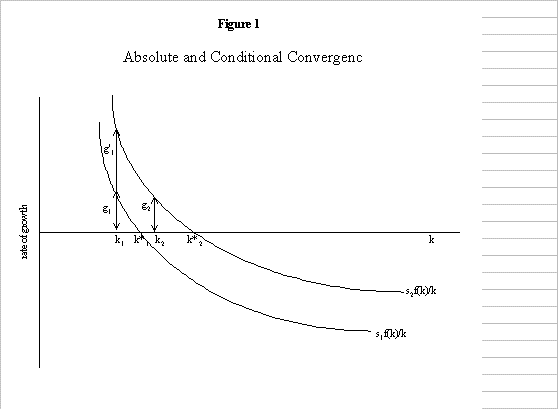
Figure 1 illustrates the difference between these two concepts
(1). Consider two economies sharing the same steady state income k2*
but with different initial conditions k1 and k2. As the figure
clearly shows, the economy with lower initial level of income will grow
faster (i.e. g1'>g2, absolute convergence). Consider, instead, two economies
with the same initial level of income k1, but with different steady
state values, k1* and k2*, respectively. In
this case, in spite of the fact that both economies share the same initial
level of per-capita income, conditional on their steady states, the economy
with the higher steady state level will grow faster (g1'>g1, conditional
convergence).
The speed of convergence is an important parameter to be assessed, not
only as a theoretical curiosity, but also because of its economic implications.
A low speed of convergence implies that countries spend much of the time
far away from their steady state. A speed of convergence of 2.5 percent
suggests that the average time that an economy spends to cover half of the
distance to its steady state is around 30 years. Therefore, medium-term
growth rates will be dominated by the transitional dynamics, only marginally
affected by changes in the steady state positions. In contrast, high speeds
of convergence imply that the economies spend much of the time in the vicinity
of their steady state. Therefore, short-term rates of growth are strongly
affected by shocks to steady states and by the long-term steady state growth
rate.
There have been many attempts to estimate the speed at which economies
approach their steady states in the empirical growth literature. Since Romer
(1986), there is a consensus on the absence of evidence in favor of the
absolute convergence hypothesis at a global level. Regressions using large
samples of countries show that rates of growth of per-capita income are
usually positively correlated with initial levels. There have been two approaches
used to deal with the differences among steady states across countries.
The first one involves restricting the sample of economies to a group
that, presumably, is homogenous enough to share a common steady state. In
this case, we are measuring local absolute convergence. The second approach
has been to deal with a cross section of heterogeneous countries and to
control the estimation of the speed of convergence using a set of variables
that proxy for the differences in the steady state positions across countries.
This is called the global conditional convergence.
Following the local absolute convergence approach, Barro and Sala-i-Martin
(1992), in their analysis for the contiguous 48 states, found a speed of
convergence of around 2 percent per year. Figure 2 reproduces their well-known
graphical evidence of convergence, showing that the poorest states at the
beginning of the century (the Carolinas, Mississippi, Georgia and Alabama)
have been growing on average twice as fast as wealthier states.
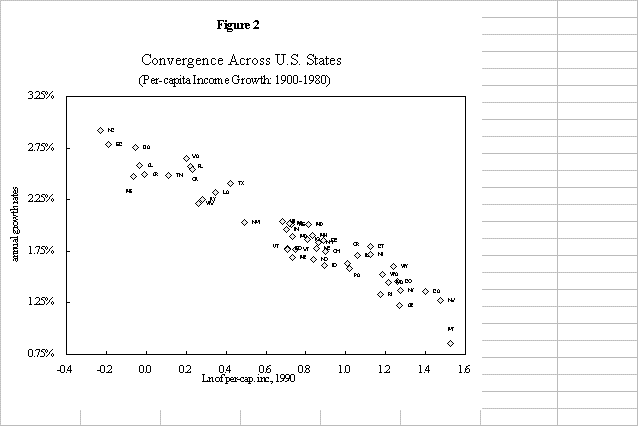
For example, South Carolina, the poorest state, had 22.4 percent of the
per capita income of New York in 1929, by 1990 this ratio had become 71.8
percent. Mississippi was the poorest state in 1940. It had 22 percent of
the per capita income of Delaware, then the wealthiest state in America.
By 1990, Mississippi, still the poorest state, already had 50 percent of
the income of the wealthiest state, now Connecticut. In 50 years, Mississippi
has been able to reduce by half the distance that separates it from the
wealthiest states.
Given the degree of cultural and economic integration among the different
states, the convergence effect must be the main reason that Mississippi
grew at a rate twice as high, on average, as that of the much wealthier
Northeastern states during the last 50 years. Figure 2 is also a useful
illustration of the "convergence frontier." The imaginary line
connecting North Carolina in the upper left of the figure and California
in the lower right corner gives an approximate idea of the position that
economies sharing the same convergence rate and steady state level must
have. Therefore, the fact that most states are aligned over this frontier
gives an idea of the high degree of homogeneity displayed by the continental
United States.
Under the conditional convergence approach, differences in steady states
across countries are controlled including, among others, the investment
ratio to GDP, measures of distortions like government consumption and black
market premium, measures of political stability, and, measures of the quality
and quantity of human capital.
The main finding of the cross-country empirical growth literature seems
to be that there exists a global conditional speed of convergence ranging
from the 2 or 3 percent of the Barro estimates to the almost 10 percent
recently obtained using dynamic panel techniques. The literature also suggests
the existence of local absolute convergence of approximately the same magnitude
in several regions (2).
The implication of these findings is that the speed of convergence has
an important impact on the medium-term process of economic growth. Countries
or states relatively homogenous in their determinants of the steady state,
but differing in their initial conditions, converge towards each other,
thereby reducing their initial differences in per capita income. The higher
the speed of convergence, the faster the process will be. In a recent paper,
Sachs and Werner (1995) point out that a sufficient condition for higher
than average growth of poorer countries is that poorer economies follow
reasonably efficient economic policies. They find strong evidence of convergence
among those countries following open trade policies and with clearly established
property rights.
In addition, for a given speed of convergence, increases in the steady
state level of per capita income at which an economy is converging will
raise the per capita income growth rate during the transition, since the
economy will have to cover a longer distance in the same time. For that
reason, an economy that is able to increase its long-run steady state per
capita income by improving the technology available, increasing the public's
confidence in its institutions, reducing market distortions, augmenting
the quality of its labor force or opening its economy to a more developed
region, will enjoy an increase in its average rate of growth due to the
convergence effect.
3 Evaluating The Performance Of Puerto Rico
In this section, we evaluate the performance of the Puerto Rican economy
when compared to the United States and to a sample of Latin American and
Caribbean countries. In particular, we are interested in determining whether
Puerto Rico is effectively on the convergence frontier traced by the states
of the Union. A negative result will indicate that Puerto Rico is not converging
towards the US, or in other words, that Puerto Rico is not closing the income
gap with the US. An interested reader can find several descriptions of the
Puerto Rican economy after World War II in Appendix 1 of this paper.
First, we will provide some graphical evidence in terms of relative measures
of output between Puerto Rico, the US, and some Latin American and Caribbean
nations. Secondly, we will present the conclusions of growth regressions
empirical evidence. Extending the work of Barro and Sala-i-Martin (1992),
panel data regressions were performed with a sample consisting of the 48
mainland United States plus Puerto Rico and Hawaii for the period 1940 to
1990. The actual equations and analysis can be found in Appendix 2 of this
paper.
The empirical evidence provided by these regressions shows that during
this period, Puerto Rico clearly performed below the predicted growth rate
implied by its initial level of per capita income, even after controlling
for a standard set of control variables. Puerto Rico is the only economy
in the sample showing such a serious under-performance. Interpreting these
results in light of neoclassical theory of growth, it is possible to argue
that even though Puerto Rico partially narrowed the income gap with the
US, it is not converging towards the per capita income of the United States.
Finally, I will show some evidence that the political status of the island
could well be the main reason for this under-performance.
3.1 Graphical Evidence
A first exercise to evaluate the performance of Puerto Rico relative
to other economies is to make pair wise comparisons of a measure of output
per capita for different economies. I use GDP per capita measured at current
international prices for Puerto Rico, the US, and a set of Latin American
and Caribbean economies, obtained from the Pen World tables version 5.6.
Figure 3a clearly indicates that the Puerto Rican economy grew faster
relative to the American economy until 1972. It shows Puerto Rican current
per capita GDP and GNP as a percentage of the same measures for the US.
Between 1955 and 1972, Puerto Rican per capita GDP moved from 22 percent
to 45 percent of American per capita GDP. Per capita GNP follows a similar
pattern although less pronounced, increasing from 19 percent to 30 percent.
The figure also shows that after 1973, the catch up force has been practically
non-existent when comparing GDP's, and it has been clearly reversed in terms
of per capita GNP. There is no clear signal that Puerto Rico will reduce
the output gap given its present political status.
Is this the normal behavior of other economies in Latin America and the
Caribbean Basin? Figures 3b to 3i plot relative measures of current output
per capita for some Latin American and Caribbean countries relative to the
US and Puerto Rico. A quick look at figures 3b-i shows that most economies
in the region have under-performed both Puerto Rico and the US.
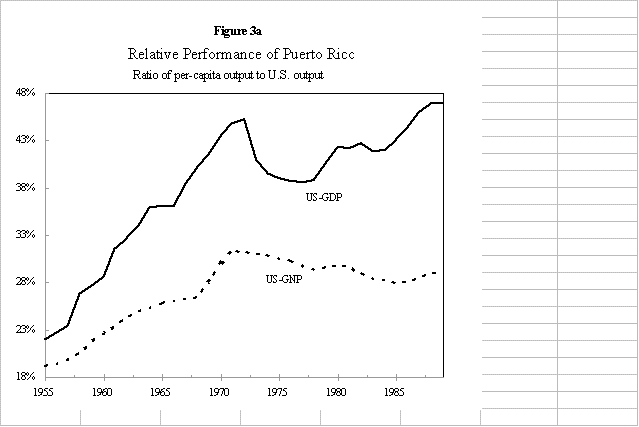
When compared to other Latin American and Caribbean economies, the performance
of the Puerto Rican economy is good in general. All the economies in the
sample became poorer compared to Puerto Rico between 1955 and 1973. All
of them show a quick recovery relative to Puerto Rico after the oil shock,
indicating that it hit the Puerto Rican economy particularly hard. After
the oil shock Puerto Rico reassumed the over-performance relative to most
economies in the sample, although much less aggressively.
In summary, Puerto Rico showed an outstanding catch-up effect in the
early post-WWII period compared to the US, out-performing all other Caribbean
and Latin American economies. However, since 1973 Puerto Rico's per capita
output growth rate has decreased relative to other economies in the region,
and there is no clear indication that it will ever be able to close the
income gap with the US.
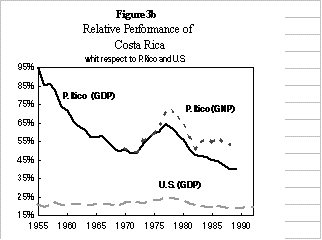 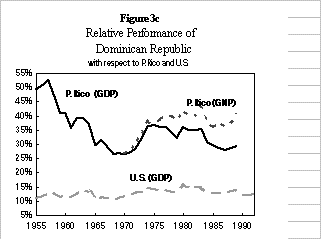 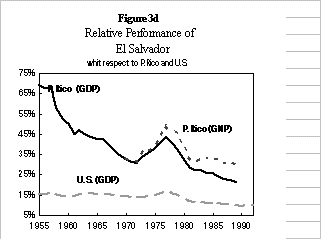 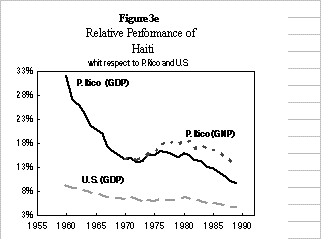 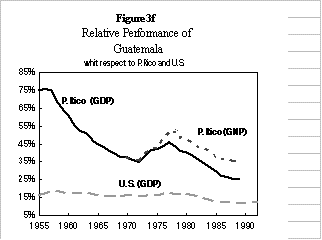 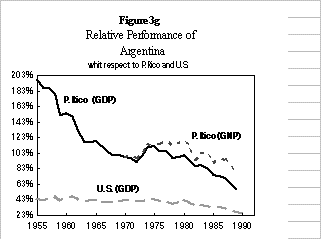 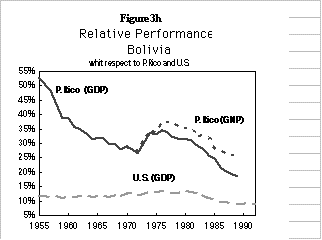 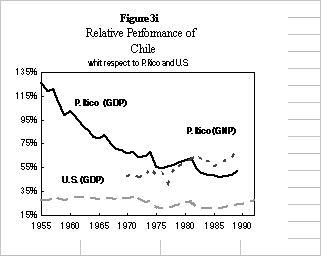
3.2 Panel Data Evidence Conclusions
The results arising from the panel data analysis (the equations for which
can be found in Appendix 2) clearly show that Puerto Rico has been growing
at a much lower rate than the one implied for a state with its initial income
level. To make this point clear, figure 4a shows the actual average annual
rates of growth of per capita income for the 49 states included in the sample
and Puerto Rico for the 50 year period under study. The data comes from
the statistical abstract of the US, and it is net of federal transfers.
The figure also plots the predicted rates of growth using the ordinary least
squares estimates presented in column 2 of table 1 (see Appendix 2). Because
this estimation procedure obtained the lowest convergence rate, it is the
most conservative estimate of Puerto Rico's under-performance. The figure
clearly shows that Puerto Rico has not been moving along the US convergence
frontier.
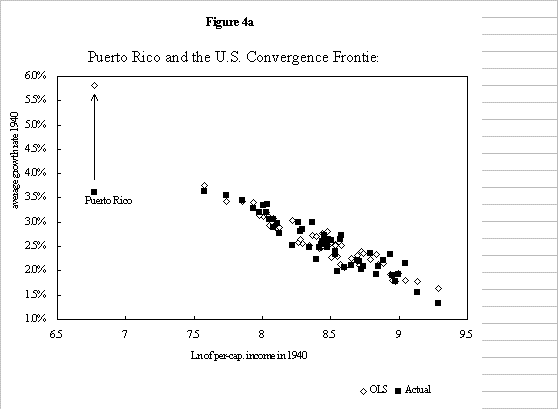
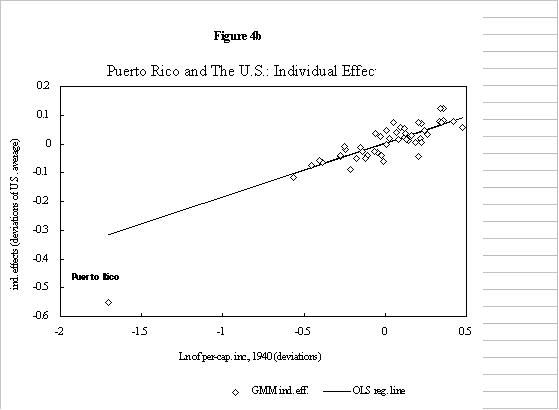
Figure 4b presents more evidence in the same direction. It makes clear
that the individual effects obtained for Puerto Rico, in terms of income
levels, estimated for the 49 states and Puerto Rico through the GMM regression
presented in column 4 of table 1, are well below the regression line. The
figure also includes the OLS regression line for individual effects on per
capita income and a dummy for Puerto Rico.
No other state economy in the sample shows a deviation comparable to
the one shown by Puerto Rico. In spite of the positive correlation between
the individual effect and the level of income, the low initial level of
per capita income is not enough to explain the large and negative individual
effect displayed by the Puerto Rican economy (3). In summary, during the
period from 1940 to 1990 the different states converged towards the steady
state level of per capita income at a rate between 2.6 and 6.0 percent per
year. Indeed, as figure 8 clearly shows, the absolute convergence frontier
is noticeable to the bare eye. In the period under study, the poorer states
out-performed the wealthier in proportion to the difference in initial levels
of income. Even though the Puerto Rican economy grew faster than almost
any other economy in the sample, the evidence indicates that the rate of
growth attained was not enough to allow Puerto Rico to converge towards
the 49 United States in the sample. Obviously, the greater the true convergence
rate operating among the states, the bigger the Puerto Rican under-performance.
After controlling for the structural composition of income, and time and
location dummies, the under-performance exhibited by the Puerto Rican is
almost 3 percentage points per year.
Explaining The Income Gap: Conditional Convergence
The results obtained in the section above show that Puerto Rico is not
on the frontier of absolute convergence drawn by the United States. There
is a huge gap between the rate at which Puerto Rico has been growing and
what we would expect from an economy with the steady state level of income
of the US and the initial level of income of Puerto Rico. In this section,
I look for an explanation of Puerto Rico's post-WWII economic under performance.
The equations and analysis can be found in Appendix 2.
Why is it that Puerto Rico has not been able to grow at this higher predicted
rate? The obvious reason is that Puerto Rico does not have the same steady
state value of per capita income of the states included in the sample under
analysis. Only after controlling for a set of determinants of the long-run
level of income we should expect to be capable of explaining Puerto Rico's
under-performance. In that case, we could conclude that in order for Puerto
Rico to be able to close the income gap with the US, the variables that
determine the steady state of the Puerto Rican economy must reach levels
equivalent to those attained by the United States.
The results of the equations provide strong evidence that Puerto Rico
has been growing at a lower rate than the one expected for an economy with
the same steady state income of the US and with the initial income of Puerto
Rico. This result remains largely unchanged after controlling for other
determinants of the steady state level of income, such as the percentage
of high school graduates in the population, the government's share of income,
and the per capita level of federal transfers. The remaining gap between
the actual and predicted individual effect for Puerto Rico must be attributed
to some other unobservable variable. Differences in technology in a broad
sense between Puerto Rico and the mainland US appear as the standard explanation
for the gap. The high degree of integration of the Puerto Rican and American
economies, however, make it implausible to attribute the gap to differences
in the access to particular production techniques or any other purely non-economic
factor.
A remaining candidate is the more obvious difference in political institutions.
Puerto Rico is the only economy of the sample without the clear and permanent
political status of statehood. The uncertainty about the future political
status of the island might certainly have hurt Puerto Rico's ability to
induce increases in the stock of capital at the rate predicted by the theory
for an economy with initial low income and high steady state level of income.
Does Statehood Matter?
As mentioned above, one of the possible causes for the inability of the
Puerto Rican economy to converge towards the United States is the unresolved
political status of the island. Statehood involves a stable legal system,
a definitive institutionality, complete access to the widest market in the
world, and the end of the uncertainty faced by any investor in the island
with respect to the future rules of the game. Statehood could also imply
that Puerto Ricans would be able to determine the nature and increase the
extent of federal aid to the island. However, statehood also implies the
end of tax incentives and the imposition of federal income taxes on the
island's residents.
Our hypothesis is that the political status of an economy affects its
growth performance. All the economies in the sample previously analyzed,
but Puerto Rico, are states, however political status is certainly not the
only difference between them and Puerto Rico. In order to disentangle the
statehood hypothesis from alternative explanations not already discarded
in the section above, I constructed a specific test of the statehood hypothesis.
I use per capita income data from 48 states from 1880 to 1940. These series
were obtained from Barro and Sala-i-Martin (1992). The idea of the test
is the following. Several of the 48 states included in this sample changed
their political status from territories to states during the period under
study. In particular, North and South Dakota, Montana and Washington became
states in 1889. Idaho and Wyoming in 1890, Utah in 1896, Oklahoma in 1907
and New Mexico and Arizona in 1912. I run then a standard growth panel regression
using cross-sections 20 years apart including a variable for political status.
This variable takes values between zero and one. It is 0 for all those observations
for which the economy was a territory. If the economy changed status during
the period it takes the proportional value. For instance it is 10/20 for
Montana for the period 1880-1900, since Montana became a state in 1890.
I found that the coefficient in the non-statehood variable is large,
negative, and significant. Given the initial level of per capita income
and the structural composition of their income, the economies of the states
have grown on average 2 percentage points faster than those of the territories.
Although these results must be interpreted carefully, it is clear they highlight
the existence of positive effects of the statehood status for growth.
4 The Cost of Converging to a Lower Steady State
The empirical evidence of this paper shows that Puerto Rico has been
converging to a lower steady state than the United States. A resulting,
simple exercise is to compare the actual trajectory of per capita income
followed by the Puerto Rican economy to the one it would have reached, had
Puerto Rico been converging to the United States.
Assume that Puerto Rico and Mississippi have already reached their steady
states. Hence, the difference in per-capita levels of steady state income
between the two economies is approximately 9,000 dollars of 1994. Under
this assumption, table 4 (Appendix 2) presents some of the resulting per-capita
income simulations, using different convergence rates. The table indicates
the amount of per capita income that Puerto Ricans have lost for not converging
towards the United States. Using the conservative convergence rate of 3.7
percent found in the study, it is possible to show that in 1994, the average
Puerto Rican had an income of almost $6,000 less than the one he would have
received, had the Puerto Rican economy converged to Mississippi, the poorest
state in the Union. Accumulating this loss from 1955 to 1994 implies that
each Puerto Rican could have been 110,000 dollars wealthier by 1994. Figure
5 illustrates this scenario comparing the two trajectories of per capita
GNP.
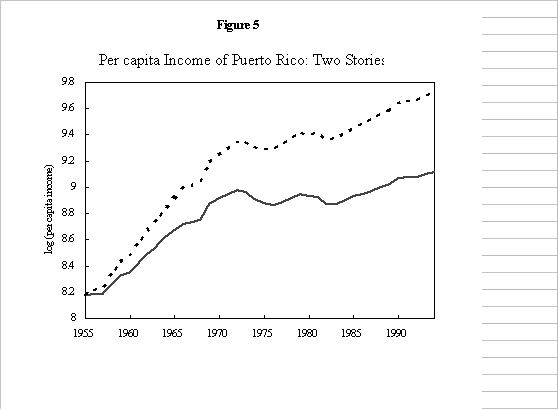
5 Summary and Conclusions
Because of its relationship with the US, Puerto Rico is economically,
politically, socially and geographically in a unique position relative to
other less developed economies. This study shows that the development strategy
pursued by Puerto Rico during the last 50 years has been, at most, only
partially successful in exploiting all the economic possibilities arising
from that preferred position.
The evidence found in this paper indicates that Puerto Rico is converging
to a lower steady state than the one to which the United States is converging
-- a shortfall that has meant Puerto Rico has been growing at a rate around
2.5 percentage points lower than the one we could expect from an economy
with its initial level of per-capita income and the steady state level of
income of the United States. Simple simulations performed using the convergence
rates obtained in this paper show that the per capita income level of Puerto
Rico could have been almost twice its actual value by 1994, completely closing
the income gap with the poorest states, had Puerto Rico been converging
towards Mississippi's actual income level since 1955.
The convergence to a lower steady state than the US implies that the
income gap will not be closed just by waiting for it to happen. Unless Puerto
Rico's steady state level of income increases substantially, the Puerto
Rican economy will never be able to close the income gap with the US. In
this sense, there is no meaningful economic reason for postponing the decision
about statehood for Puerto Rico.
Although growth theory does not provide a recipe for faster growth, it
does indicate that if Puerto Rico manages to improve the variables that
determine its long-run equilibrium income, the convergence effect guarantees
a higher rate of growth during the transition towards the new steady state.
Statehood could be able to improve these variables by increasing political
stability and thereby increasing the flow of investment from the mainland
-- and elsewhere -- in a more natural way than tax incentives ever could.
Several examples demonstrate the positive effects of a cooperative relationship
between a less developed economy and a wealthy, developed country or region.
Middle-income European economies like Spain in the 60's and Greece, Ireland
and Portugal have been profiting from their geographical position for a
long time, gradually closing the gap with the wealthiest European economies.
The most important political and economic accomplishment of these economies
in the last 40 years has been their entry into the European Economic Community
by increasing the advantage of the geographical proximity to a wealthier
economic region. As shown by Larre and Torres (1991), the combination of
market reforms and integration into the EEC have allowed Spain and Portugal
to outperform wealthier European countries in the last ten to fifteen years.
All these examples, however, are minor cases of economic cooperation
when compared to the potential for Puerto Rico. Were Puerto Rico to become
a state, the convergence effect should guarantee Puerto Rico a higher rate
of economic growth and its citizens higher income levels. Through the statehood
process, Puerto Rico can become an integral part of the largest and wealthiest
economy in the world, resolving once and for the question of political uncertainty
associated with commonwealth and thereby fully enjoying the economic benefits
of the catch-up process.
Appendix 1: The Puerto Rican Economy After World War II
The purpose of this section is to provide a simple description of the
economic performance of Puerto Rico during the period after World War II.
I will show that the performance of the Puerto Rican economy was solid in
terms of growth and other economic indicators at least until the early 1970's.
It was during that period that Puerto Rico was able to reduce the output
gap with the US and become an industrialized economy, with economic and
social indicators comparable to more developed economies.
After World War II, Puerto Rico implemented policies in order to move
from an agricultural economy to an industrial one. A first stage of economic
reforms from the early 1940's to 1949 focused mainly on a program of land
reform, development of infrastructure, and reorganization of institutions.
A second stage of economic development reforms by the name "Operation
Bootstrap" were set in place from 1945 to 1953. This second phase was
designed to increase industrial production by attracting private capital,
especially from American investors, through privatization of government
owned enterprises and tax incentives.
No major economic reforms were undertaken after 1953. From then on, the
Puerto Rican government adapted its policies, especially those regarding
tax incentives, in a way to satisfy American investor's needs and keep them
coming to the island. In the following 35 years, subsidiaries of American
corporations established in Puerto Rico, leading the subsegment income in
the contribution of manufacturing to GNP from 15 percent in 1950 to more
than 50 percent in 1990. In 1952, the Commonwealth of Puerto Rico was established.
After the oil shock in 1973, the Puerto Rican economy slowed down. The
reasons for this are not definitive, but several events may have had an
exogenous effect. They include: the application of the minimum wage to Puerto
Rico; the failure to adjust fully to the aftermath of the oil shock; and,
the shift of tax induced American investment from labor to capital intensive
industries. Nevertheless, the United States economy came through the oil
shock and resumed its economic growth, so another reason for the Puerto
Rican slowdown might be found elsewhere.
Figure A1.1 shows the steep climb of the Puerto Rican economy until 1973
and how it tapers off thereafter. It depicts Puerto Rican real GDP per capita
from 1955 to 1994. Puerto Rico has managed to increase its per capita GDP
at an average rate of 3.7 percent per year between 1955 and 1994. The growth
has not been steady. Until 1972, per capita GDP grew at an average annual
rate of 5.9 percent, out-performing most of the other middle-income economies
of the world. However, after 1972, the Puerto Rican economy grew at a discrete
2.1 percent per year in per capita terms, with a low 0.4 percent between
1973 and 1983.
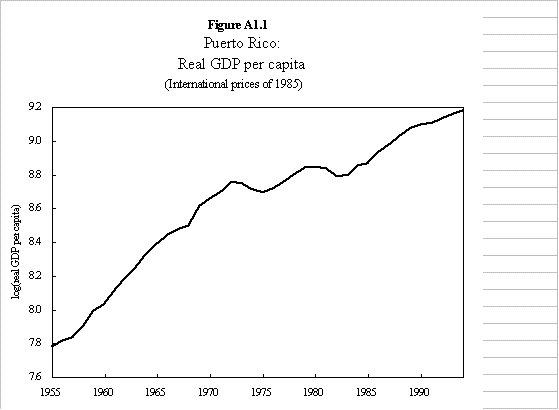
Figure A1.2 shows the effects of "Operation Bootstrap," designed
to increase industrial production by attracting capital from external investors.
It was believed that after a first stage of intensive use of external sources,
domestic capital would follow up, completing the transition towards an industrial
economy. Domestic capital never did materialize to a significant degree
as successive Puerto Rican governments came to rely increasingly on tax-induced
external funding sources.
The figure shows total investment as a share of GDP from 1955 to 1994.
The average rate of investment was 29.2 percent between 1955 and 1972. It
dropped to 17.0 percent between 1973 and 1983, and further down to 14.3
from 1984 to 1994. The external funds, mainly from the mainland represented
40.7 percent of total sources in 1955, reaching almost 80 percent by 1980.
The internal sources of investment have been mainly depreciation reserves
and government savings, with negative private savings.
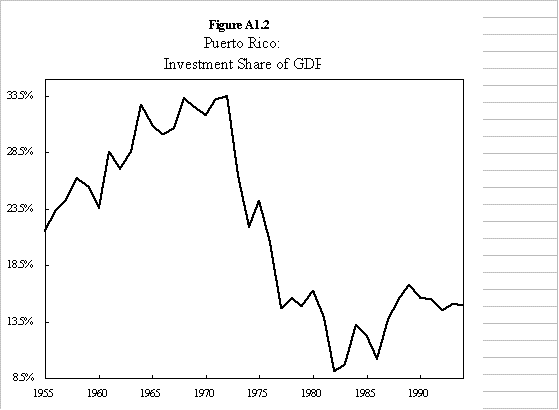
The presence of so many external sources in capital (in the form of repatriated
returns to the mainland) is an obvious drain on the Puerto Rican economy.
Figure A1.3 shows the significant disparity between GDP and GNP. It shows
GNP as a percentage of GDP from 1955 to 1994. The figure shows that the
share of output belonging to Puerto Ricans has steadily decreased from more
than 100 percent in the early 1950's to less than 70 percent in 1994.
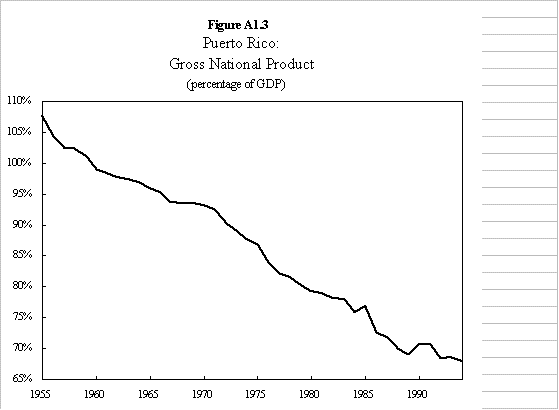
The income effectively received by the Puerto Ricans would have been
even smaller had Puerto Rico not received a large amount of transfers from
the US federal government. Figure A1.4 shows the amount of net federal transfers,
both to individuals and the Puerto Rican government, in per capita dollars
in 1985 and as a percentage of per capita GNP. The figure shows that these
transfers have amounted, on average, to almost 22 percent of per capita
GNP since 1974. Even though Puerto Rico receives fewer federal transfers
in per capita terms than any other state, they represent a larger share
of per capita income because of the much lower per capita income level of
the island.
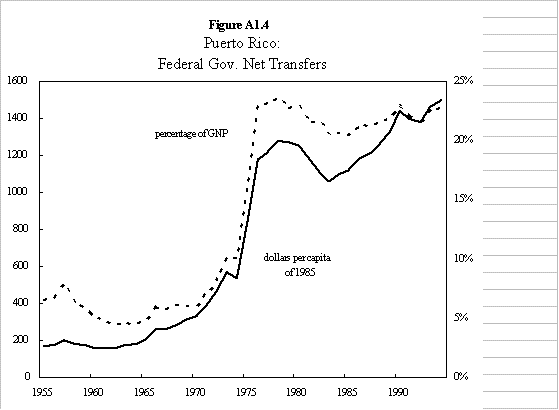
Economists often blame the disproportionately large amount of transfers
for the lack of private savings generated by Puerto Ricans. It has been
argued that federal transfers have financed consumption, especially considering
that since 1974 direct benefits to individuals (mainly in the form of social
security and food stamps) account for more than 70 percent of total federal
aid. In fact, by the late 1980's consumption was already over 95 percent
of GNP, and by 1990 disposable personal income exceeded GNP.
Another notable characteristic of Puerto Rico is the totally external
orientation of the economy. Figure A1.5 shows the concentrations of imports
and exports -- what has been argued to be one of the main problems of the
Puerto Rican development strategy. By the late 1980's, exports plus imports
amounted to almost 140 percent of GDP. This trade is largely concentrated
with the US. More than 90 percent of exports are sent to the mainland and
almost 70 percent of imports come from the US.
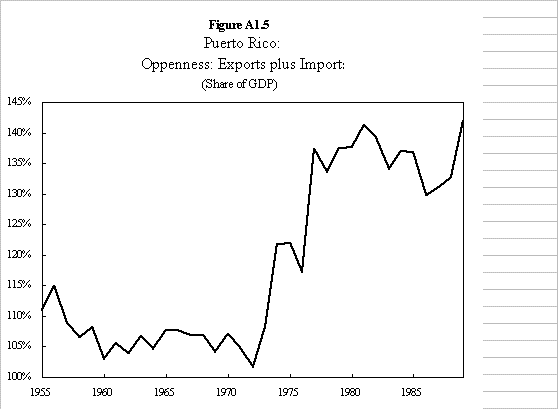
American firms attracted through the tax incentives to the island have
constituted themselves in export enclaves with almost no forward or backward
linkages with the Puerto Rican economy. These firms would import raw materials,
put them together, and export finished products directly to the mainland,
building almost no interactions with the local economy (4).
In addition to the tax incentives offered by "Operation Bootstrap",
low wages were a significant incentive for American corporations with operations
in the island. Taylor (1957) calculated that wages 25 percent higher than
those prevailing by 1953 would have been enough to offset the tax advantages
and discourage most of the American firms from moving to the island. Puerto
Rican average wages were only 30 percent of American wages by 1955, almost
60 percent by the mid 1980's, and they are 75 percent today. Partially responsible
for this increase in relative wages in the island has been the minimum wage
legislation. In 1977 the federal minimum wage began to be applied to Puerto
Rico, with several exceptions for determined industries. By 1981 almost
all the Puerto Rican economy was subject to the federal minimum wage.
Despite this disproportionate minimum wage, there is no evidence that
this legislation has had any effect on unemployment. Unemployment rates
have always been high in Puerto Rico, ranging from a low of 10.3 percent
in 1970 to a high of 23.4 percent in 1983. The average unemployment rate
for the postwar period has been 16 percent. This unemployment rate is particularly
high if one considers that the participation rate in Puerto Rico has been
less than 45 percent since 1980, that unemployed Puerto Ricans have the
choice to move to the mainland, and that the government of Puerto Rico has
been generating more than 20 percent of total employment since 1980.
Summary
In spite of all the problems that the Puerto Rican development strategy
has had, following WWII Puerto Rico was able to move closer, in terms of
per capita output, to wealthier and more developed economies. In particular,
the Puerto Rican economy did narrow, to some extent, its income gap with
the US. This catch-up effect has often been described as a consequence of
the beneficial effects achieved by the cooperation between a developed and
an underdeveloped economy.
Baumol and Wolf (1994) first elaborated on the catch-up effect by Puerto
Rico during the postwar era. They show that labor productivity in Puerto
Rico grew from less than 25 percent of the US level in 1950 to 75 percent
in 1990. A similar pattern is observed for per capita GDP, although it is
less pronounced. They also point out that several social and economic indicators
for Puerto Rico demonstrate that the Puerto Rican economy has experienced
in many areas development comparable to wealthier economies. They conclude
that Puerto Rico's post-WWII history demonstrates how much can be accomplished
when a wealthy, developed economy cooperates and interacts with one that
is initially less developed.
Using a growth accounting analysis, they found that the existence of
an educated labor force was the primary reason for Puerto Rican rapid economic
growth during the postwar period, explaining over a third of the increase
in per capita GDP. The catch-up effect explains between 16 and 38 percent
of the growth, Puerto Rico's investment rate another 16-21 percent, and
its trade openness and scientific manpower accounts for much of the remainder.
A neoclassical growth interpretation suggests that substantially increasing
Puerto Rico's ability to accumulate physical and human capital (the development
strategy initiated after the war) might have moved the economy's long-run
expected income toward the US, initiating a process of convergence which
explains the relatively long period of high growth rates. Unfortunately,
as this study shows, Puerto Rico is no longer converging toward the US and
therefore no longer enjoys the positive economic effects of convergence.
Appendix 2: Panel Data Evidence: Equations, Tables and Analysis
2.a. Estimation Procedure
The empirical analysis of the economic performance of Puerto Rico is
conducted by estimating standard growth regressions, which arise from the
following empirical equations. It has been shown elsewhere that the standard
Solow-Swan and Ramsey Cass-Koopmans models imply that the average growth
between and and  is given by is given by
 (1)
where (1)
where 
 is the annual rate of convergence, is the annual rate of convergence,  the per-capita income of economy i at time the per-capita income of economy i at time  , ,  is a set of explanatory
variables controlling for differences in steady states, is a set of explanatory
variables controlling for differences in steady states,  is an unobservable
individual effect, is an unobservable
individual effect,  is a time-specific effect,
and is a time-specific effect,
and  is an error term. is an error term.
A significantly negative coefficient on lagged per-capita income is consistent
with the convergence prediction of the neoclassical model of growth. Ceteris
paribus, the further away an economy is to its steady state, the higher
will be its rate of growth of per-capita income.
2.b. Puerto Rico and the US
The purpose of the following estimations is to assess the central question
of the paper. Namely, whether Puerto Rico is converging to the US. If Puerto
Rico behaved as an American state, its per capita income would have been
converging during the last fifty years towards that of the wealthier states.
In that case, the Puerto Rican economy would lay on the convergence frontier
traced by the American states as shown in figure 1b, displaying absolute
convergence with the US.
Absolute Convergence
I use two different procedures for testing whether Puerto Rico belongs
to the American convergence frontier. The simplest one assumes that the
49 American states in the sample share the same technology and institutions
and, therefore, no major unobservable differences or individual effects
among them. In this case, I can just estimate a simplified version of equation
(1) through pooled ordinary least squares including a dummy variable for
Puerto Rico. The equation would not include the term  and therefore, and therefore,
 (2) (2)
Following Barro and Sala-i-Martin (1992) I included in equation (2) as
an additional explanatory variable, the variable  o
that proxies for common effects related to the sectoral composition
of per-capita income for each state. The inclusion of this variable accounts
for sectoral shocks that affect the performance of states with similar income
composition in the same direction. As long as the initial level of per-capita
income is related to the income composition, the removal of o
that proxies for common effects related to the sectoral composition
of per-capita income for each state. The inclusion of this variable accounts
for sectoral shocks that affect the performance of states with similar income
composition in the same direction. As long as the initial level of per-capita
income is related to the income composition, the removal of  o
would seriously bias the estimation of the convergence rate. The variable o
would seriously bias the estimation of the convergence rate. The variable
 o is given by o is given by

where wijt-t
is the participation of sector j in state i's personal
income, and yit
is the amount of per-capita income originated in sector j
at a national level.
A negative significant  would indicate
that Puerto Rico has not been growing at the rate implied by its initial
level of per capita income, had Puerto Rico and the 49 states shared the
same steady state. It would indicate, therefore, a rejection of the hypothesis
that Puerto Rico has behaved like a US state. would indicate
that Puerto Rico has not been growing at the rate implied by its initial
level of per capita income, had Puerto Rico and the 49 states shared the
same steady state. It would indicate, therefore, a rejection of the hypothesis
that Puerto Rico has behaved like a US state.
In a more general setting one could still argue for the presence of individual
effects asserted above, if there are differences in the set of available
technologies due, for instance, to morphological differences across states.
The estimation problems arising from the presence of correlated individual
effects in equation (1) have been extensively analyzed (5). In general,
an OLS regression of equation (1) will provide inconsistent estimates of
all parameters. In particular, the estimate of  will be biased
downwards due to the obvious correlation between the lagged per-capita income
and the individual effect. will be biased
downwards due to the obvious correlation between the lagged per-capita income
and the individual effect.
Following Caselli, Esquivel and Lefort (1994), I also perform general
method of moments estimation of equation (1) (6). In the case of this regressions,
an unusually large and negative individual effect for Puerto Rico would
support the hypothesis that Puerto Rico does not behave as a typical U.S.
state. Given that the individual effects are likely to be correlated with
income, we should require the individual effect for Puerto Rico to be unusually
large (in absolute value) after controlling for income.
I estimate different variants of equations (1) and (2) for a panel of
five cross-sections, at 10-year intervals, covering the period 1940-1990.
The regressions were run using ordinary least squares and general method
of moments procedures. In the OLS regressions I also included regional dummies
for south, midwest, and west geographical location, and a time dummy for
each period. The GMM regressions were run in deviations with respect to
the mean. The individual effects obtained in the GMM regressions were run
against income levels using OLS.
Table A2.1
Cross - State Regressions for per-capita Income
| |
OLS |
OLS |
GMM |
GMM |

|
0.7684 |
0.6867 |
0.0578 |
0.0546 |
| |
(0.0123) |
(0.0210) |
(0.0022) |
(0.0024) |
| Inc. Comp. |
0.2732 |
0.5166 |
|
0.1684 |
| |
(0.0326) |
(0.0950) |
|
(0.0563) |
| |
|
|
|
|
| DUM loc |
yes |
yes |
no |
no |
| DUM time |
no |
yes |
yes |
yes |
| DUM prico |
-0.0221 |
-0.0331 |
|
|
| |
(0.0046) |
(0.0047) |
|
|
 |
0.0263 |
0.0376 |
0.0548 |
0.0605 |
| |
(0.0016) |
(0.0031) |
(0.0038) |
(0.0044) |
| ind. effects DUM prico |
|
|
|
-0.0238 |
| |
|
|
|
(0.0048) |
The  estimates are not comparable across
estimation procedures. estimates are not comparable across
estimation procedures.
I use personal per-capita income obtained from the Statistical Abstract
of the U.S. that includes data for Puerto Rico from 1940 on. The data is
net of federal transfers. Table A2.1 summarizes the results obtained in
both sets of regressions. The convergence rate obtained using pooled least
squares is 2.63 percent when including only location dummies and 3.76 percent
when time dummies are also included. The estimate of  obtained using
the general method of moments procedure is 5.48 percent and 6.05 percent
per year respectively. In all cases, the standard errors are small, implying
significant coefficients and small confidence intervals with no overlapping
regions. The coefficient obtained with the general method of moments estimator
is unquestionably larger than the ones obtained via least squares(7). The
coefficient on the structural composition of income variable is always positive
and significant. obtained using
the general method of moments procedure is 5.48 percent and 6.05 percent
per year respectively. In all cases, the standard errors are small, implying
significant coefficients and small confidence intervals with no overlapping
regions. The coefficient obtained with the general method of moments estimator
is unquestionably larger than the ones obtained via least squares(7). The
coefficient on the structural composition of income variable is always positive
and significant.
The coefficient on the dummy variable for Puerto Rico included in the
OLS regressions is large, negative and significant. It indicates that Puerto
Rico grew during the period 1940-90, on average at a rate between 2.2 and
3.3 percentage points lower than that of an economy with the same steady
state as the United States, but with the initial per capita income of Puerto
Rico. The table also shows the coefficient of a dummy variable for Puerto
Rico in the OLS regression of the individual effects on the level of income.
Interpreting this coefficient in terms of growth rate under-performance
indicates the extraordinarily large and negative individual effect obtained
for Puerto Rico accounts for 2.38 percentage points of lower annual growth
rate. These results clearly indicate that Puerto Rico does not behave like
another state. The Puerto Rico economy has been growing at a much lower
rate than the one implied for a state with its initial income level.
2.c Explaining the Income Gap: Conditional Convergence
When an economy does not belong to the convergence frontier, it is because
it does not share the same steady state income determinants. Therefore,
II include in the above regression a set of standard determinants of growth
variables that proxy for steady state conditions. Although the under-performance
is somewhat reduced, I still find a large and unexplained growth gap.
I estimate equations 1 and 2 including as explanatory variables beginning
of period values of per capita income the state's structural composition
of income, and the percentage of the population over 25 years old with complete
high school educations or more. I include, in addition, the per capita level
of state and local government expenditure, and the per capita level of federal
aid received by the state. Table A2.2 presents the results. Controlling
for the extra set of variables increases, as expected, the estimated speed
of convergence to 3.77 percent and 3.14 in the OLS regressions with and
without including time dummies respectively. The speed of convergence reaches
9.51 percentage the GMM regression. The coefficient for the structural composition
of income variable is positive and significant in all regressions. The coefficient
of the education variable is not significantly different from zero in the
OLS regressions, but negative and highly significant in the GMM regressions.
The negative sign obtained is consistent with the percentage of the adult
population with complete high school educations being a proxy for the initial
level of human capital and therefore reflecting initial conditions. The
coefficient in government expenditure and aid from the Federal Government
are significant and positive in both sets of regressions. Federal aid has
a large effect on growth, is especially in the GMM regressions. This is
interesting, since the general method of moments estimation procedure takes
care of potential problems of endogeneity of the explanatory variables that
might certainly arise, especially in the case of this last variable.
Table A2.2
Cross-State Regressions for per-capita Income
| |
OLS |
OLS |
GMM |
 |
0.7302 |
0.6862 |
0.0387 |
| |
(0.0266) |
(0.0243) |
(0.0012) |
| Inc. comp. |
0.2481 |
0.5647 |
0.2894 |
| |
(0.0333) |
(0.0958) |
(0.0138) |
| H-S Grad. |
0.0033 |
0.0137 |
-0.1511 |
| |
(0.0086) |
(0.0106) |
(0.0033) |
| GOV |
0.0270 |
0.0044 |
0.0077 |
| |
(0.0081) |
(0.0074) |
(0.0005) |
| FAID |
0.0796 |
0.0678 |
0.2274 |
| |
(0.0312) |
(0.0293) |
(0.0046) |
| DUM loc |
yes |
no |
no |
| DUM time |
no |
yes |
yes |
| DUM prico |
-0.0335 |
-0.0324 |
|
| |
(0.0048) |
(0.0048) |
|
 |
0.0314 |
0.0377 |
0.0905 |
| |
(0.0036) |
(0.0035) |
(0.0032) |
| Ind. effects: DUM prico |
|
|
-0.0116 |
| |
|
|
(0.0035) |
The estimates are not comparable across
estimation procedures. estimates are not comparable across
estimation procedures.
Table A2.2 also shows that the under-performance of Puerto Rico is still
severe. There is almost no change in the OLS estimate of the Puerto Rican
dummy: it is 3.24 percent when I include the time dummies. However, the
individual effect obtained through the GMM estimation is somewhat smaller.
The OLS dummy obtained for Puerto Rico's individual effect indicates that
the average rate of growth during the transition path was 1.1 percentage
points lower than expected.
Table A2.3
Determining the Effect of Statehood on Growth
| |
1880-1940 |
 |
0.6923 |
| |
(0.0500) |
| Agric. Share |
-0.0576 |
| |
(0.0001) |
| non-STATEHOOD |
-0.002
(0.0001) |
| |
|
| DUM loc |
YES |
 |
0.0184 |
| |
(0.0036) |
In order to test the hypothesis that the political status of an economy
affects its performance in terms of growth, I use per capita income data
from 48 states from 1880 to 1940. These series were obtained from Barro
and Sala-i-Martin (1992). The idea of the test is the following. Several
of the 48 states included in this sample changed their political status
from territories to states during the period under study. In particular,
North and South Dakota, Montana and Washington became states in 1889. Idaho
and Wyoming in 1890, Utah in 1896, Oklahoma in 1907 and New Mexico and Arizona
in 1912. I run then a standard growth panel regression using cross-sections
20 years apart including a variable for political status. This variable
takes values between zero and one. It is 0 for all those observations for
which the economy was a territory. If the economy changed status during
the period it takes the proportional value. For instance it is 10/20 for
Montana for the period 1880-1900, since Montana became a state in 1890.
Table A2.3 presents the results of this regression. Following Barro and
Sala-i-Martin, I included also the share of income originating in agriculture
as a measure of the structural composition of income. I also included dummies
for the south, west and mid-west areas. The results are striking. Table
A2.3 shows that the coefficient in the non-statehood variable is large,
negative, and significant. That is, given its initial level of per capita
income and structural composition of their income, the economies of the
actual states have grown faster after they became states. Although these
results must be interpreted carefully, it is clear that they highlight the
existence of positive effects for growth of the statehood status.
2.d. Puerto Rico, Latin America And The Caribbean
In spite of the apparent under-performance of the Puerto Rican economy
with respect to the US, the post-WWII economic history of Puerto Rico has
been used as an example of successful economic development.
In this section I use the recently available data from the Penn World
Tables version 5.6. that provide data on GDP at international prices for
Puerto Rico allowing the international comparisons to be made. I used the
Barro and Lee (1994) sample of 97 countries plus Puerto Rico. Figure A2.1a
clearly summarizes the successful Puerto Rican story. I have selected from
the sample of 97 countries all the Latin American and Caribbean economies
plus USA, Canada, and Puerto Rico. The figure makes clear that Puerto Rico
out-performed all the economies with similar or lower per-capita income
as of 1960.
In order to identify sources of growth for Puerto Rico, I ran panel regressions
built using cross-sections of 98 countries (included Puerto Rico) at five
year intervals from 1960 to 1990. I included as explanatory variables some
of the most common control variables used in the standard literature on
empirical growth. For education I use the percentage of the population over
25 years old with secondary school completed. I also included fertility
rates, investment rates, government expenditure ratios, black market premium,
and number of revolutions. Table 4 summarizes the results. As before, I
ran regressions using a standard OLS procedure and a GMM estimation. The
convergence rates are 2.28 percent an 9.49 percent respectively. The estimated
coefficients for the education variable are positive and significant, but
small. The coefficients on all other variables are reported in Table A2.4
as well. They are similar to those obtained in previous studies.
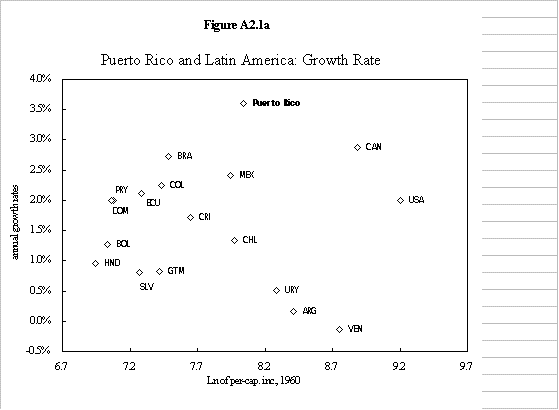
The results for Puerto Rico and Latin America and the Caribbean are summarized
through figure A2.1b. The figure presents individual effects obtained in
the determinants of growth GMM regression presented in Table A2.4 column
2, for the sample and period previously described. The figure shows that
Puerto Rico does not present a particularly large individual effect. That
is, most of Puerto Rico's good performance is explained for the accumulation
process through investment, its human capital, its initial position, and
other variables. Once we take into consideration those determinants of the
economy steady state, there is not much left unexplained. The relatively
low individual effect (lower than the one for the U.S.) indicates that most
of the relative performance of Puerto Rico, when compared to a broad set
of countries, is explained by its relatively high steady state level of
per-capita income, which is captured by the control variables included in
the regressions.
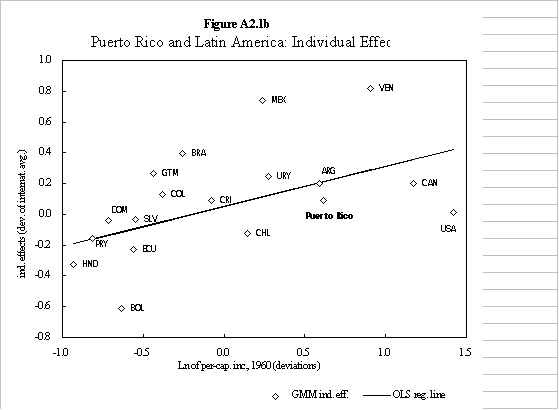
Table A2.4
Cross-Country Regressions of per-capita GDP
| |
OLS |
GMM |
 |
0.0781 |
0.0301 |
| |
(0.0029) |
(0.0086) |
| educ. |
0.0049 |
0.0154 |
| |
(0.0021) |
(0.0076) |
| fertility rate |
0.0591 |
-0.0596 |
| |
0.0141 |
0.0550 |
| I/GDP |
0.1311 |
0.1334 |
| |
(0.0224) |
(0.0362) |
| G/GDP |
-0.0481 |
0.1219 |
| |
(0.0198) |
(0.1433) |
| ln (1+BMP) |
-0.0231 |
-0.0348 |
| |
(0.0043) |
(0.0118) |
| revolutions |
0.0086 |
0.0064 |
| |
(0.0054) |
(0.0137) |
 |
0.0247 |
0.117 |
| |
(0.0037) |
(0.0276) |
2.e The Cost of Converging to a Lower Steady State
In order to compare the actual trajectory of per capita income followed
by the Puerto Rican economy to the one it would have reached had it moved
along the US convergence frontier, I use well known results on neoclassical
growth theory. The trajectory of income per-effective worker, 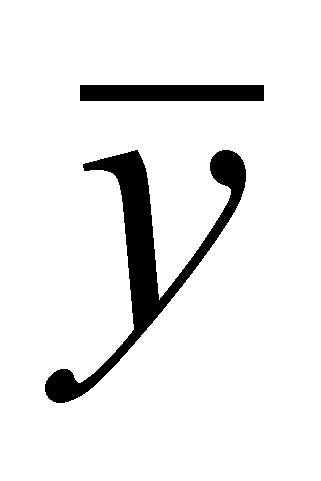 , around the steady state, , around the steady state,  , is governed
by the following relationship , is governed
by the following relationship
 (3) (3)
This trajectory is a function of the convergence rate  . A simple transformation
of equation (3) allows us to simulate the trajectory of income under different
convergence rates and steady state values. . A simple transformation
of equation (3) allows us to simulate the trajectory of income under different
convergence rates and steady state values.
 (4) (4)
Table A2.5
The Cost of Converging to a lower Steady state
| |
Mississippi |
US Average |
| Convergence Rate |
Income Lost in 1944 |
Total Income Lost since 1955 |
Income Lost in 1994 |
Total Income Lost since 1955 |
| 2% |
3,777 |
67,366 |
6,159 |
107,335 |
| 3.7% |
5,800 |
110,928 |
9,864 |
182,232 |
| 6% |
7,143 |
148,745 |
12,462 |
252,363 |
Equation (4) indicates the increase in per-capita income obtained as
a consequence of an increase in the steady state level of per-capita income
(8). Table A2.5 presents simulations of the cost for Puerto Rico of converging
to a lower steady-state. The calculations make use of equation 4 to simulate
income trajectories under different parameter values.
Endnotes
- The figure plots the rate of growth on its vertical axis, and the stock
of capital on its horizontal axis.
- In a series of regressions using cross-sectional and pooled-panel approaches,
the estimates obtained for the speed of convergence have fluctuated between
2.5 and 3 percent per year. A rate of convergence that fluctuates between
5 and 9 percent has been found in studies that apply econometric techniques,
which correct for unobservable differences across countries (i.e., individual
effects) arising from differences in the technology available.
- The evidence provided in table 1 of Appendix 2 and shown in figures
3a and b indicates that Puerto Rico grew at an annual rate between 2.2
and 3.3 percentage points below the one predicted for a state with the
initial level of income of Puerto Rico.
- See Hexner, Jenkins, Ladd and LaMotte (1993).
- See Caselli, Esquivel and Lefort (1994) for a review of the estimation
problems and solutions.
- The procedure consists of eliminating the individual effects by taking
differences to equation (1) and instrumenting the right-hand side variables
using all their lagged values. In the absence of serial correlation in
the error term eit , this estimator provides consistent estimates
of the parameters in equation (1). For a more extensive description of
the estimator see Arellano and Bond (1992), and Caselli, Esquivel and Lefort
(1994).
- The difference between both set of estimates is smaller, however, than
the one shown by Caselli, Esquivel and Lefort (1994) for a large sample
of heterogeneous countries, indicating that the omitted variable bias is
less severe for this sample.
- The results from simulations of equation 4 performed under different
scenarios are reported in Table 5.
References
Barro, Robert (1991); "Economic Growth in a Cross-section of Countries",
Quarterly Journal of Economics , CVI, 407-443.
Barro, R. and J.W. Lee (1994a); "Losers and Winners in Economic
Growth", it Proceedings of the World Bank Annual
Conference on Development Economics , The World Bank, 267-297.
Barro, R. and J. W. Lee (1994b); Data Set for a Panel of 138 Countries,
mimeo, Harvard University.
Barro, R., G. Mankiw and X. Sala-i-Martin (1994); "Capital Mobility
in Neoclassical Growth Models", forthcoming, American Economic
Review.
Barro, R. and X. Sala-i-Martin (1991); "Convergence Across States
and Regions", it Brooking Papers on Economic Activity
, no. 1, 1991a, 107-158.
Barro, R. and X. Sala-i-Martin (1992); "Convergence", Journal
of Political Economy , 100, April, 223-251.
Barro, R. and X. Sala-i-Martin (1994); Economic Growth , forthcoming,
Mc Graw Hill.
Baumol, William J. (1986); "Productivity Growth, Convergence and
Welfare: What the Long-Run Data Show", American Economic Review
, December, 1976, 1072-1085.
Baumol, William J. and Edward N. Wolff (1994); "Puerto Rican Catch
Up in the Postwar Period: the Fifth Tiger?", mimeo , 1994.
Caselli, Francesco, Gerardo Esquivel and Fernando Lefort (1996); "Reopening
the Convergence Debate: A New Look at Cross-Country Growth Empirics",
Journal of Economic Growth, September.
Dietz, James L. (1986), it Economic History of Puerto Rico , Princeton
University Press.
Hexner, J. Tomas, G. Jenkins, H.F. Ladd and K.R. LaMotte (1993); "Puerto
Rican Statehood: A Precondition to Sound Economic Growth", October.
Islam, Nazrul (1993); "Growth Empirics: A Panel Data Approach",
forthcoming, Quarterly Journal of Economics
Islam, Nazrul (1994); "An Inquiry into the Economic Prospects of
Puerto Rico", International Institute for Advanced Studies
, Working Paper No.1.
Knight, M., N. Loayza and D. Villanueva (1993); "Testing the Neoclassical
Growth Model", IMF Staff Papers .
Larre, B. and R. Torres (1991); "Is Convergence a Spontaneous Process?
The Experience of Spain, Portugal and Greece", OECD Economic
Studies , 16.
Lefort, Fernando (1996), "Is Puerto Rico Converging to the United
States", mimeo Harvard University.
Levine, R. and D. Renelt (1992); "A Sensitivity Analysis of Cross-Country
Growth Regressions", American Economic Review , September,
942-963.
Mankiw, G., D. Romer and D. N. Weil (1992); "A Contribution to the
Empirics of Growth", Quarterly Journal of Economics ,
CVII, 407-437.
Price Waterhouse (1991); "Benefits and Costs of Section 936",
Puerto Rico, U.S.A. Foundation mimeo , May.
Sala-i-Martin, Xavier (1994); "Cross-Sectional Regressions and the
Empirics of Economic Growth", European Economic Review
, April, 739-747.
Sachs, J. D. and A. M. Warner (1995); "Economic Convergence and
Economic Policies", NBER Working Paper No. 5039.
Solow, Robert (1956); "A Contribution to the Theory of Economic
Growth", Quarterly Journal of Economics , 70,
February, 65-94.
Swan, T. W. (1956); "Economic Growth and Capital Accumulation",
The Economic Record , November, 334-361.
|


![]() obtained using
the general method of moments procedure is 5.48 percent and 6.05 percent
per year respectively. In all cases, the standard errors are small, implying
significant coefficients and small confidence intervals with no overlapping
regions. The coefficient obtained with the general method of moments estimator
is unquestionably larger than the ones obtained via least squares(7). The
coefficient on the structural composition of income variable is always positive
and significant.
obtained using
the general method of moments procedure is 5.48 percent and 6.05 percent
per year respectively. In all cases, the standard errors are small, implying
significant coefficients and small confidence intervals with no overlapping
regions. The coefficient obtained with the general method of moments estimator
is unquestionably larger than the ones obtained via least squares(7). The
coefficient on the structural composition of income variable is always positive
and significant.

![]() , around the steady state,
, around the steady state, ![]() , is governed
by the following relationship
, is governed
by the following relationship![]() . A simple transformation
of equation (3) allows us to simulate the trajectory of income under different
convergence rates and steady state values.
. A simple transformation
of equation (3) allows us to simulate the trajectory of income under different
convergence rates and steady state values.